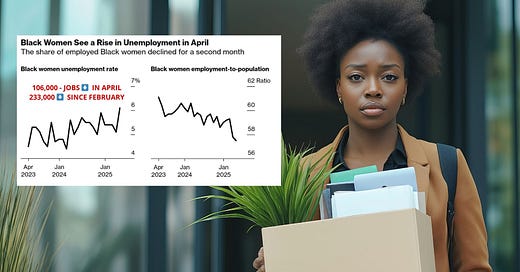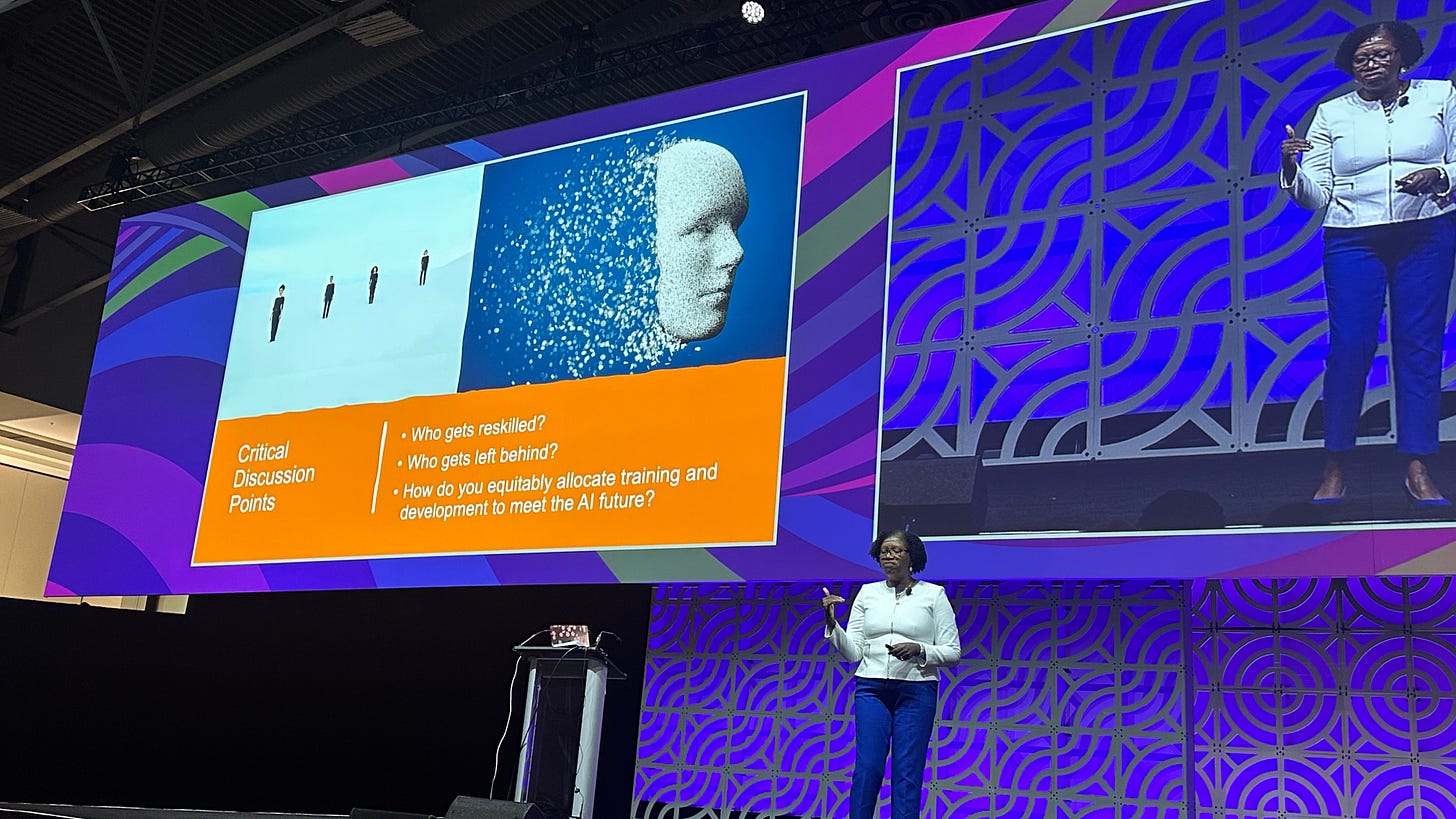Existential Crisis: Black Women's Unemployment and AI Disruption
The Three Factors Destroying Black Women's Employment
Black women lost 304,000 jobs in just three months while America celebrated economic growth—revealing how AI disruption isn't a future threat but a present crisis devastating the community that can least afford it. Federal cuts, the dismantling of DEI, and AI have created a perfect storm for displacement. The future of work is being written now—and Black America must write its own story.
Could it be that AI is Reshaping Work—But Not Equally? The rise of artificial intelligence is revolutionizing the workforce, but for Black professionals, the promise of innovation also brings disproportionate risk.
While AI is often celebrated as a driver of progress, it is rapidly automating roles that have historically served as critical mobility pathways for Black workers, especially those without access to advanced degrees or elite college networks.
The crisis is no longer theoretical—it's happening now. In April and May 2025, Black women experienced the most severe employment setback of any demographic group, with unemployment rates jumping from 5.1% to 6.3% while the national rate remained stable at 4.2%. Black women lost 106,000 jobs in April alone, representing the most significant single-month job loss among all racial and gender groups despite overall economic growth.
The scale of devastation is staggering. Black women have lost 304,000 jobs from February through April 2025, with approximately 198,000 jobs lost between February and March, followed by another 106,000 in April. While some recovery occurred in May, Black women remain down 233,000 jobs for the year to date, representing employment levels at a five-month low. This employment collapse happened when the overall economy added hundreds of thousands of jobs, highlighting how economic growth can mask the targeted devastation of specific communities.
The Employment Crisis Unfolds: Multiple Forces Converging
The spring 2025 unemployment spike reveals how multiple forces converge to devastate Black women's economic security. While white women maintained 3.4% unemployment and Hispanic women stayed at 4.6%, Black women faced a 2.9 percentage point gap—among the most significant recorded disparities in recent years.
Federal Workforce Reductions: Black women comprise 12% of federal workers versus 7% of the civilian workforce. Since January 2025, federal employment declined by 26,000 jobs since January 2025, and Black women experienced a 33% decline in federal employment compared to just 3.7% for the overall workforce.
DEI Program Elimination: The systematic dismantling of Diversity, Equity, and Inclusion programs across federal agencies and private corporations removed positions where Black women were heavily concentrated, eliminating critical pathways to professional advancement.
AI and Automation Displacement: Administrative and office support occupations—where Black women are overrepresented—face the highest generative AI exposure. Nearly 19 million workers in these roles face displacement risk, with Black women bearing a disproportionate impact.
This represents a dramatic reversal from early 2024 when Black women achieved historic unemployment lows of 4.2%. The rapid deterioration underscores how quickly progress can unravel when structural supports are removed.
The AI Effect Is An Existential Crisis.
By 2030, up to 4.5 million jobs held by Black Americans could be displaced by AI and automation. According to McKinsey, this figure represents a 10% greater risk than for the general population. The most at-risk roles are office support, customer service, food services, production, truck drivers, and mechanical repair.
Today, 24% of Black employees are in jobs where more than 75% of tasks are automatable, compared to just 20% of White workers. For Black women specifically, 79% work in AI-exposed occupations compared to 58% of men, with particular vulnerability in administrative support roles. As generative AI grows more capable, these stepping-stone jobs are being pulled from underfoot. The result? A potential collapse in one of the few accessible bridges to upward mobility for Black communities.
The Breadwinner Crisis: Understanding the Financial Stakes
The employment data reveals why Black women's job losses create cascading economic devastation. Black mothers carry financial responsibility at rates far exceeding other demographic groups, creating a vulnerability that policymakers and employers have largely ignored.
The Three Categories of Financial Responsibility:
Sole Breadwinners (Single Mothers): These women are the only income source for their families. When they lose jobs, household income drops to zero. Among Black women who are primary income providers, 75.4% are single mothers and caregivers.
Primary Breadwinners: Married or partnered women earning at least 50% of the household income. Job loss means families lose their majority income source, often dropping below poverty thresholds.
Co-Breadwinners: Women contributing 25-49% of household income. While partners may earn more, these women's income is essential for basic family stability—covering childcare, healthcare, sandwich generation caregiving costs, or housing costs.
This data means Black families face disproportionate risk when employment disruptions occur for Black Women.
When a Black woman loses her job, the family often faces immediate crises: inability to pay rent, loss of health insurance, food insecurity, and potential homelessness. The April-May 2025 data showing 304,000 Black women losing employment represents hundreds of thousands of families pushed toward economic catastrophe.
The Scissors Effect: Reskilling Beyond Traditional Middle-Skill Roles
The risk isn't just economic—it's existential. Black women face a "scissors effect": displacement from traditional middle-skill roles without access to newly created technology positions. Only 3% of computing roles are held by Black women, limiting access to AI-adjacent job creation.
Why this financial structure amplifies crisis impact: If these inequities go unaddressed, the racial wealth gap could widen by an additional $43 billion annually by 2045. Already, Black professionals face higher unemployment rates, slower career advancement, and limited access to reskilling. With the onset of AI, those disparities will widen and create calculated barriers to entry for Black professionals.
The fear is real. In a recent national survey, 53% of Black professionals reported concern that AI will replace their jobs within five years, compared to 39% of White professionals. The April-May 2025 data proves these fears are justified. And yet, Black workers are also more likely to embrace AI tools proactively, showing both deep anxiety and a strong desire to adapt.
The Moment of Truth: What Happens Next
The convergence of AI displacement and policy-driven employment devastation has created an inflection point. The spring 2025 data doesn't just represent job losses—it represents a stress test of America's commitment to economic equity. How institutions, organizations, and society respond in the next 12-18 months will determine whether we build inclusive AI-powered prosperity or cement algorithmic apartheid.
Speaking recently at the ATD Talent Development Conference, I posed a question that cuts to the heart of this crisis: "Who gets reskilled and who gets left behind?" Standing on that main stage, I shared data that made the audience visibly uncomfortable—24% of Black workers are trapped in jobs with over 75% automation potential compared to just 20% of white workers, and 53% of Black professionals already fear AI will replace them within five years.
These aren't abstract statistics; they're the lived anxieties of millions of workers who see the writing on the wall. When I revealed that 4.5 million jobs held by Black Americans face automation-driven displacement by 2030, the room fell silent. The spring 2025 employment data proves we're not talking about a distant future—we're witnessing the early stages of a transformation that will either lift communities up or leave them permanently behind.
For Black Women: The data validates what many have already sensed—that individual excellence isn't enough to overcome structural barriers. Collective action, strategic skill development, and community-building become survival strategies. The women who navigate this transition successfully will likely be those who combine technical competence with advocacy and mutual support.
For Organizations: This is the moment to prove that diversity commitments extend beyond marketing campaigns. Companies that proactively protect and advance Black women through AI transitions will access untapped talent and avoid the reputational and legal risks of discriminatory AI implementation. Those who don't will face workforce crises and accountability measures from increasingly organized advocacy groups.
For Policymakers: The employment data demands emergency intervention, not just future planning. Federal employment restoration, AI bias auditing mandates, and targeted reskilling investments aren't just policy options but economic necessities. The alternative is watching entire communities fall through the cracks of technological progress.
However, given the current political environment, where DEI programs have been systematically dismantled, and federal employment is being slashed, we cannot expect policymakers to prioritize Black economic security. The spring 2025 employment data is a stark reminder that when political winds shift, Black communities are the first to suffer. We must stop waiting for institutional rescue and start building our own economic infrastructure. No one is coming to save us—we need and must save ourselves.
The Choice Before Us: We can engineer equity into AI adoption or automate existing inequalities at an unprecedented scale. The spring 2025 employment crisis is both a warning and an opportunity, showing us exactly what's at stake and exactly who gets hurt first when we fail to act.
Today is the moment to choose equity, not efficiency. Purpose, not passivity. And intentional transformation, not another round of disruption that leaves the most vulnerable behind.
Keep reading with a 7-day free trial
Subscribe to The Undisruptable Woman with Margaret Spence to keep reading this post and get 7 days of free access to the full post archives.






